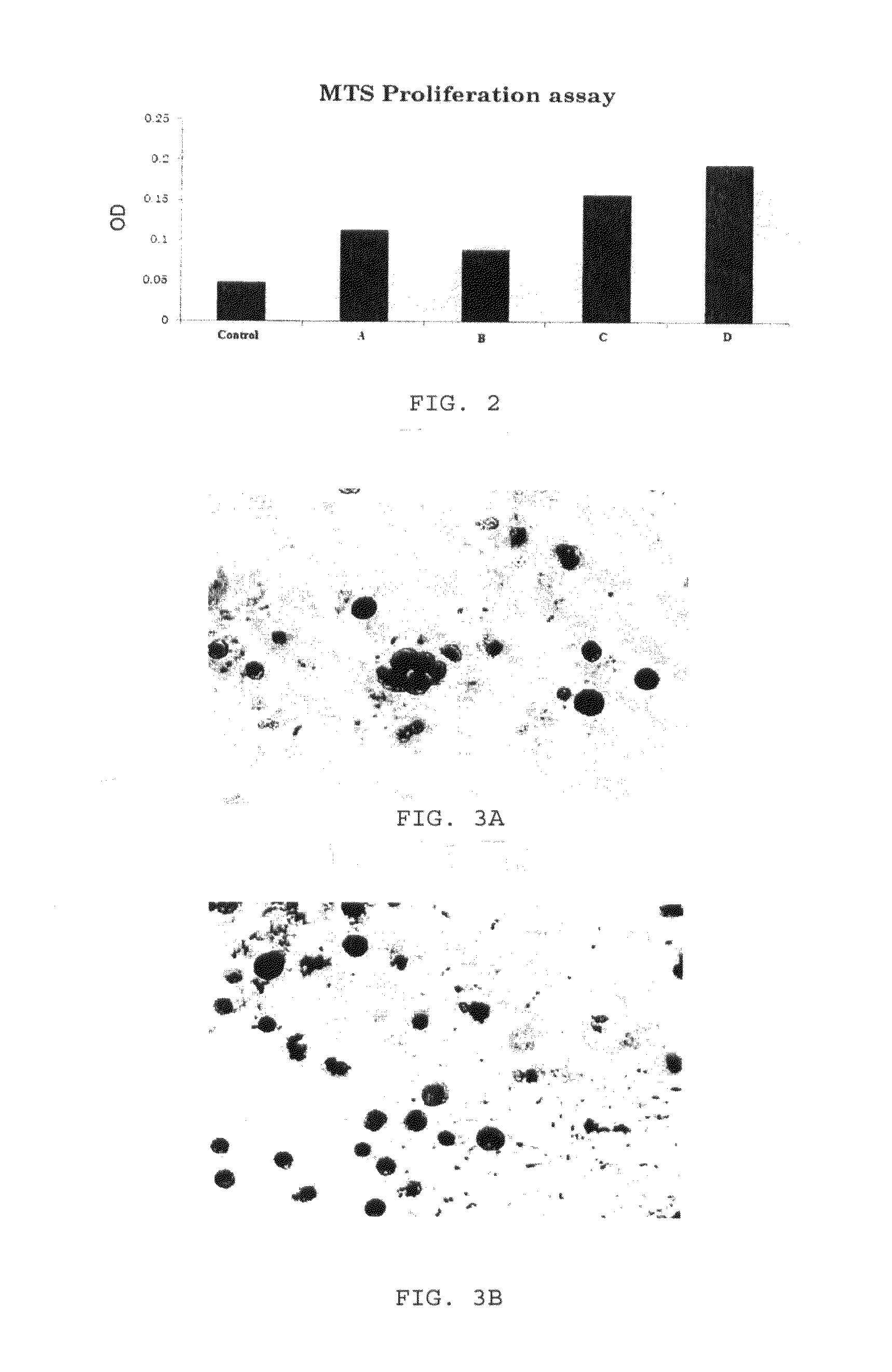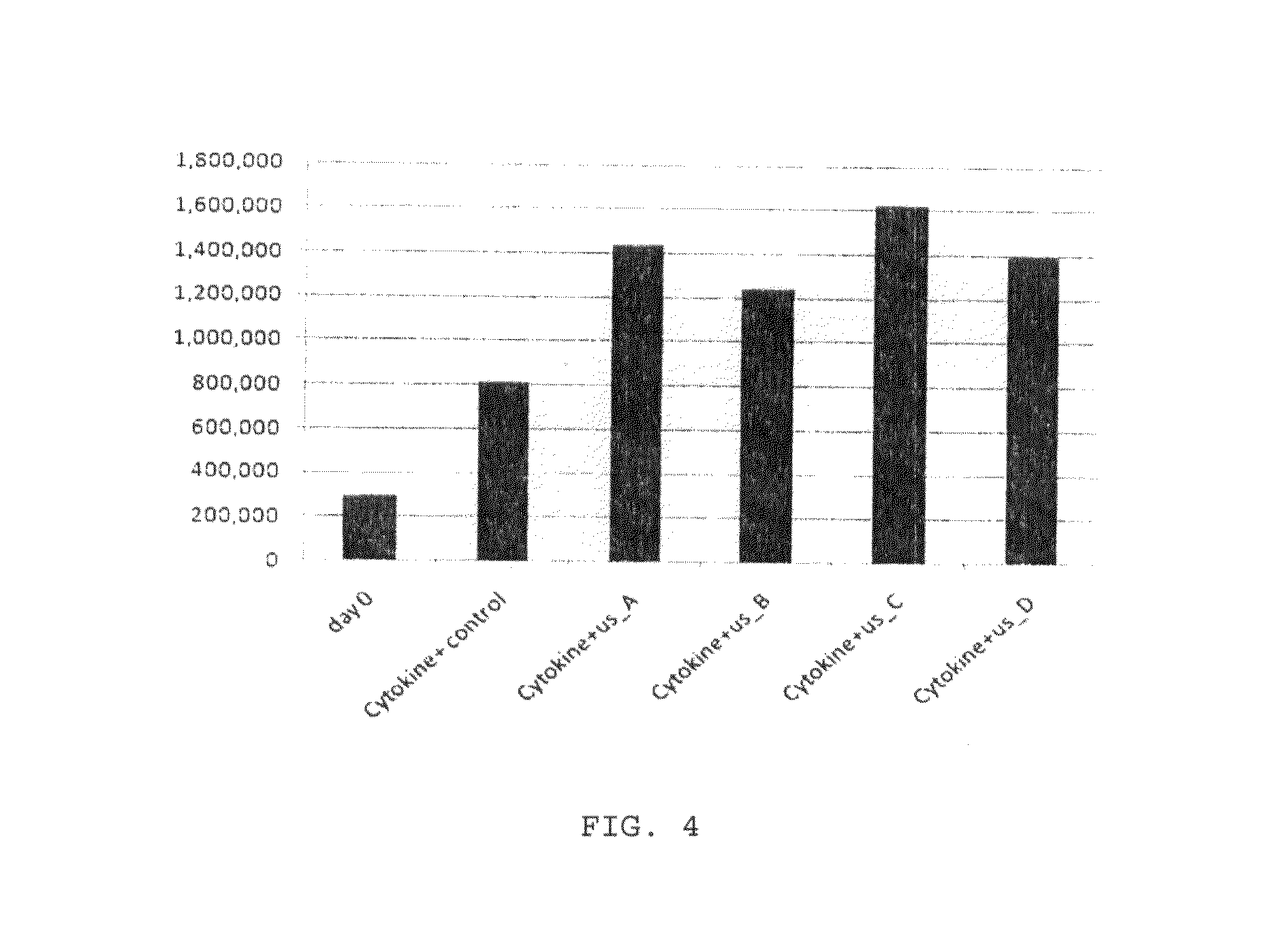Enhanced animal cell growth using ultrasound
a technology of animal cells and ultrasound, applied in the field of increasing animal cell growth, can solve the problems of taking scientists many years of trial and error to learn to derive and maintain stem cells in the laboratory, and stem cells cannot work with their neighbors to pump blood through the body, etc., and achieve the effect of increasing the rate of cell proliferation
- Summary
- Abstract
- Description
- Claims
- Application Information
AI Technical Summary
Benefits of technology
Problems solved by technology
Method used
Image
Examples
example 1
Isolation of CD34+ Hematopoietic Stem / Progenitor Cells (HSPC)
[0057]Leukophoresis product (LP) was obtained with the patients' informed consent (in accordance with the institutional guidelines approved by the Human Research Ethics Board of the University of Alberta).
[0058]LP was used to isolate CD34+ hematopietic stem / progenitor cells (HSPC) using immunomagnetic beads (Miltenyi-Biotec, Auburn, Calif.) according to the manufacturer's instructions. Briefly, light-density mononuclear cells were separated by density gradient centrifugation over 60 percent Percoll (GE Healthcare, Quebec, Canada), labeled with a CD34+ antibody (QBEND 10) and passed through a positive selection column. The purity of isolated CB CD34+ cells was more than 92% as determined by fluorescence-activated cell sorter (FACS) analysis.
example 2
Stimulation with Low-Intensity Pulsed Ultrasound (LIPUS)
[0059]All cells were then maintained in Iscove's modified Dulbecco's medium (IMDM, GibcoBRL, Long Island, N.Y., USA) supplemented with 20% bovine growth serum (BGS; Hyclone, Logan, Utah, USA) and combination of cytokines (SCF: 100 ug / ml, TPO: 50 ug / ml, Flt3-ligand: 50 ug / ml) for four days as described below.
[0060]To stimulate the cultured cells with low-intensity pulsed ultrasound (LIPUS), a device producing a 1.5-MHz ultrasound wave, 20% duty cycle, with adjustable output intensity between 30 mW / cm2 to 100 mW / cm2 was used To enable cultured cells to be treated by ultrasound, four ultrasound transducers were fitted on a plastic frame and connected to the control panel of the signal generator via four independent cables. The cells (3×105) were seeded in 12-well plates for all the experiments. The operation of the transducers was checked before each experiment. The plates were placed on ultrasound transducers using a coupling gel...
example 3
Cell Proliferation and Viability
[0061]Cell proliferation and viability was assessed at day 5 by trypan blue exclusion and 3-(4,5-dimethylthiazol-2-yl)-5-(3carboxymethoxyphenyl)-2-(4-sulfophenyl)-2H-tetrazolium (MTS) cytotoxicity assay, using CellTiter 96 AQueous One Solution (Promega, Madison, Wis.). Briefly, 3×105 cells per well were stimulated by LIPUS in combination with a cytokine cocktail (SCF: 100 ug / ml, TPO:50 ug / ml, Flt3-ligand: 50 ug / ml) for four days. For trypan blue exclusion assay, cells were resuspended in culture medium were stained by addition an equal volume of 0.4% trypan blue (Sigma, St. Louis, Mo.) in PBS and counted using a Neubauer haemocytometer.
[0062]In order to perform MTS assay, CellTiter 96 AQueous One Solution (20 μl per 100 μl medium) was added into each well, and cells were incubated at 37° C. for 1-4 h. The absorbance (490 nm) was measured, and cell proliferation ratios were calculated as the ratio of absorbance in treated cells versus that in untreated...
PUM
 Login to View More
Login to View More Abstract
Description
Claims
Application Information
 Login to View More
Login to View More - R&D
- Intellectual Property
- Life Sciences
- Materials
- Tech Scout
- Unparalleled Data Quality
- Higher Quality Content
- 60% Fewer Hallucinations
Browse by: Latest US Patents, China's latest patents, Technical Efficacy Thesaurus, Application Domain, Technology Topic, Popular Technical Reports.
© 2025 PatSnap. All rights reserved.Legal|Privacy policy|Modern Slavery Act Transparency Statement|Sitemap|About US| Contact US: help@patsnap.com



